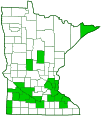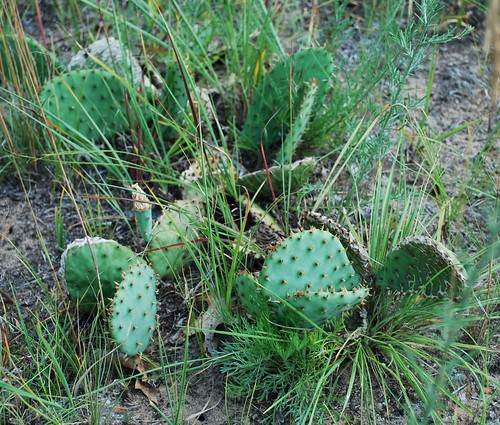plains prickly pear
(Opuntia macrorhiza)
Conservation • Description • Habitat • Ecology • Use • Distribution • Taxonomy
|
|
|||||||||||||
Description |
Plains prickly pear is a low, succulent, spiny, perennial shrub that rises from tuberous, somewhat woody roots. It usually forms a 3″ to 6¼″ high mound but may also form a 24″ to 60″ in diameter mat. The stems are prostrate or spreading, branched, and often divided into 2 or 3 segments (pads). The pads are not easily detached. If broken apart, the separated segment can send down new roots and form a new plant. Each pad is greatly flattened, egg-shaped to circular, 2¾″ to 4¼″ long, and 1⅜″ to 3″ wide. It is dark green, dull, and hairless. It is covered with a thick, waxy skin. It is usually fleshy and usually smooth but may become flabby and wrinkled with the approach of winter or when stressed. On the surface of each pad are a number of woolly patches (areoles). Areoles are actually extremely short modified branches. They are widely spaced, mostly ⅜″ to 1¼″ apart, and are arranged in diagonal rows. The row at the widest part of the pad has usually 5 or 6, sometimes 7 or 8, areoles. Each areole is oval to circular and 1 ⁄16″ to ⅛″ in diameter. It is covered with a dense tuft of numerous 1 ⁄16″ to 3 ⁄16″ long barbed hairs (glochids). The glochids are pale yellowish-brown or tan at first, becoming brown as they age. They have minute downward-pointing barbs and are easily detached. All areoles usually also have 1 to 4 true spines. Spines are denser toward and on on the margins of the pad. The spines are white to reddish-brown, straight, needle-shaped, stout at the base, erect to spreading, and ⅜″ to 2¼″ long. They are round or only slightly flattened on cross section. They are not easily detached. The inflorescence is 1 to several flowers rising singly from areoles on the margin of the pad. The flowers are broadly funnel-shaped, 2″ to 3″ in diameter, and showy. There are 3 petals, 3 petal-like sepals (6 tepals), numerous stamens, and 1 style. The tepals are tepals are 1″ to 1½″ long, the outer tepals shorter than the inner. The outer tepals are egg-shaped and green at the base grading to yellow at the margins. The inner tepals are inversely egg-shaped to spoon-shaped and have an abrupt, short, sharp point at the tip. They are mostly yellow but usually tinged with orange or red at the base. The stamens have long slender filaments and small yellow anthers. The style is stout and has 4 to 9 stigma lobes. The fruit is an elongated, inversely egg-shaped, 1″ to 1½″ long, ⅝″ to 1⅛″ in diameter berry with numerous seeds. It is fleshy, juicy, hairless, and green at first, becoming dull red or purple when ripe. The fruit has glochids, sometimes restricted to the upper margin, but no spines. It matures from mid-July to mid-September. It is edible. |
Height |
3″ to 6¼″ |
Flower Color |
Yellow |
Similar Species |
Brittle prickly pear (Opuntia fragilis) stems are smaller and only slightly flattened. They do not look like pads. |
Habitat |
Dry. Prairies, dunes, lakeshores. Rocky or sandy soil. Full sun. |
Ecology |
Flowering |
Mid-June to July |
Pests and Diseases |
|
Use |
|
Distribution |
||
|
Sources |
|
| 5/24/2025 | ||
Nativity |
||
Native |
||
Occurrence |
||
Common |
||
Taxonomy |
|
Kingdom |
|
Division |
Tracheophyta (Vascular Plants) |
Subdivision |
Spermatophytina (Seed Plants) |
Class |
|
Subclass |
Caryophyllidae |
Superorder |
Caryophyllanae |
Order |
Caryophyllales (Pinks, Cactuses, and Allies) |
Family |
Cactaceae (cactus) |
Subfamily |
Opuntioideae |
Tribe |
Opuntieae |
Genus |
Opuntia (prickly pears) |
According to the Minnesota DNR’s Rare Species Guide there is disagreement as to which species of Opuntia, O. humifusa or O. macrorhiza, occurs in Minnesota, but there is agreement that only one does. The Minnesota Biodiversity Atlas reports 37 collected specimens as O. humifusa and only 2 as O. macrorhiza. Some authorities use the Minnesota Biodiversity Atlas as one of their sources or their only source of species distribution in the state. BONAP shows only O. humifusa in the state. USDA PLANTS shows both species occurring in the state with almost identical distributions. The Minnesota DNR acknowledges the confusion and uses the name O. macrorhiza for all occurrences in the state. According to Flora of North America, O. macrorhiza inner tepals are red at the base while those of O. humifusa are yellow throughout. The photos on the DNR’s Rare Species Guide, and photos on MinnesotaSeasons.com, show flowers with red at the base of the inner tepals. If the FNA descriptions are correct, then the correct name for prickly pears in Minnesota with large, pad-like segments is O. macrorhiza. |
|
Subordinate Taxa |
|
|
|
Synonyms |
|
Opuntia grandiflora Opuntia macrorhiza var. macrorhiza Opuntia leptocarpa Opuntia mackensenii Opuntia plumbea Opuntia sphaerocarpa Opuntia compressa var. grandiflora Opuntia compressa var. macrorhiza Opuntia compressa var. stenochila |
|
Common Names |
|
grassland pricklypear plains prickly pear plains prickly-pear plains twistspine pricklypear tuberous prickly pear twist-spine prickly-pear twistspine pricklypear western prickly pear |
|
Glossary
Areole
A well-defined, woolly, hairy, or cushion-like structure, unique to cacti, from which spines, glochids, branches, and flowers originate.
Filament
On plants: The thread-like stalk of a stamen which supports the anther. On Lepidoptera: One of a pair of long, thin, fleshy extensions extending from the thorax, and sometimes also from the abdomen, of a caterpillar.
Glochid
A small, barbed or hooked hair or bristle on a cactus.
Sepal
An outer floral leaf, usually green but sometimes colored, at the base of a flower.
Stigma
In plants, the portion of the female part of the flower that is receptive to pollen. In Odonata and Hymenoptera, a blood-filled blister or dark spot at the leading edge of each wing toward the tip, thought to dampen wing vibrations and signal mates. In Lepidoptera, an area of specialized scent scales on the forewing of some skippers, hairstreaks, and moths.
Style
On plants: Part of the pistil, usually a slender stalk, connecting the ovary to the stigma(s). On flies (Diptera): A terminal, often slender or pointed, appendage arising from the end of the last, usually third, antennal segment.
Tepal
Refers to both the petals and the sepals of a flower when they are similar in appearance and difficult to tell apart. Tepals are common in lilies and tulips.
Visitor Photos |
||
Share your photo of this plant. |
||
This button not working for you? |
||
Verónica Aponte |
||
Pricky Pear in Minneapolis It is in the sidewalk flower patch in front of my house |
||
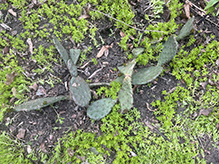 |
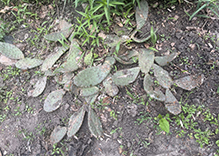 |
|
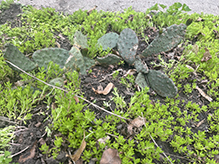 |
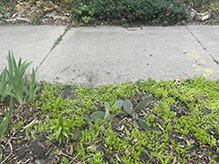 |
|
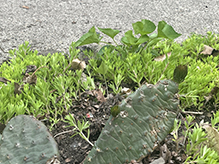 |
||
MinnesotaSeasons.com Photos |
||
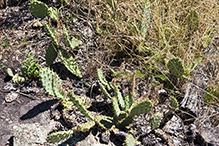 |
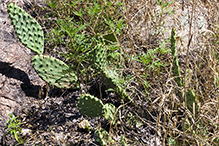 |
|
Plant |
Plant |
|
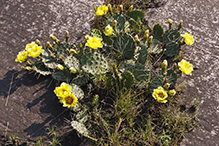 |
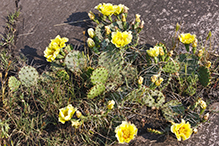 |
|
Flowering plant |
Flowering plant |
|
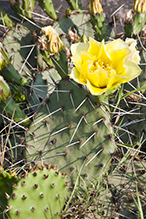 |
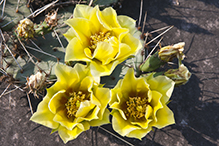 |
|
Flowering plant |
Inflorescence |
|
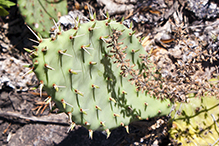 |
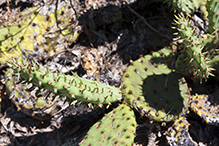 |
|
Young pad |
Young pad |
|
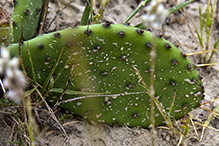 |
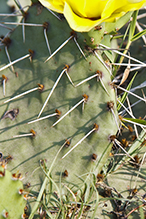
|
|
Mature pad |
||
|
||
|
Spines |
|
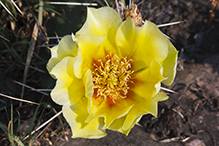 |
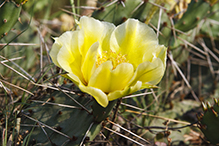 |
|
Flower |
Flower |
|
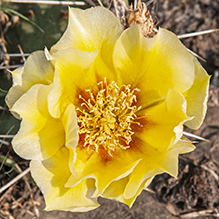
|
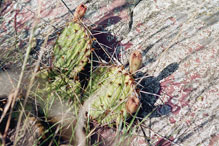 |
|
Fruiting plant |
||
|
||
Flower |
||
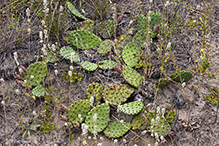 |
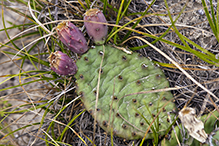 |
|
Fruiting plant |
Infructescence |
|
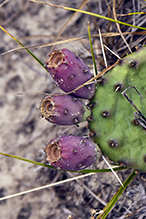
|
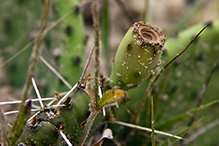 |
|
Fruit |
||
|
||
|
||
Infructescence |
|

Visitor Videos |
||
Share your video of this plant. |
||
This button not working for you? |
||
|
Other Videos |
||
Opuntia Macrorhiza in Oklahoma |
About
Uploaded on Nov 6, 2009 A video of Opuntia Macrorhiza and its habitat I filmed whilst visiting Oklahoma in October 2009. List of noticed companion plants: |

Visitor Sightings |
||
Report a sighting of this plant. |
||
This button not working for you? |
||
Verónica Aponte |
Location: Minneapolis, MN 55412 It is in the sidewalk flower patch in front of my house |
 |
MinnesotaSeasons.com Sightings |
||

|
Created: 9/7/2005 Last Updated: © MinnesotaSeasons.com. All rights reserved. |
